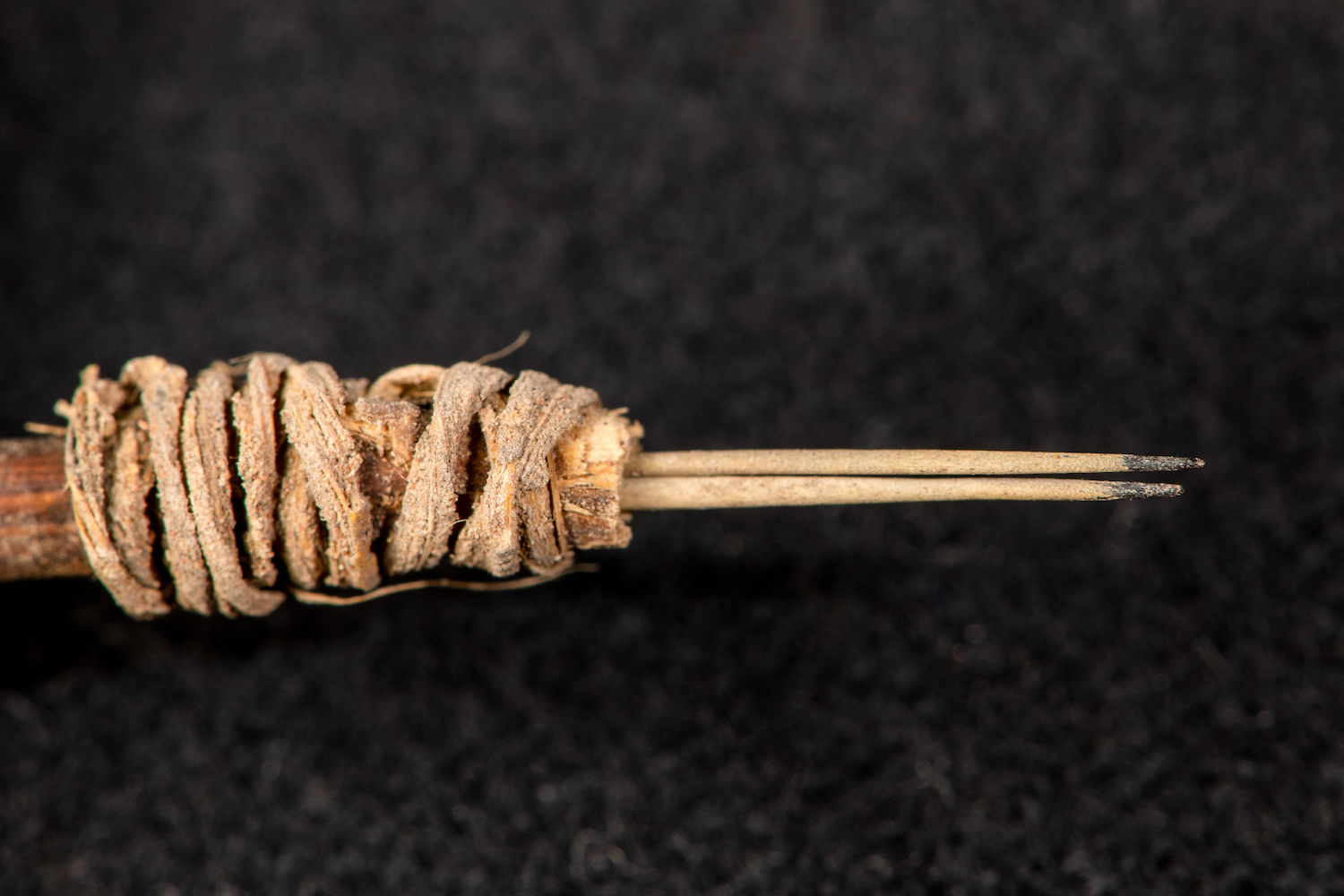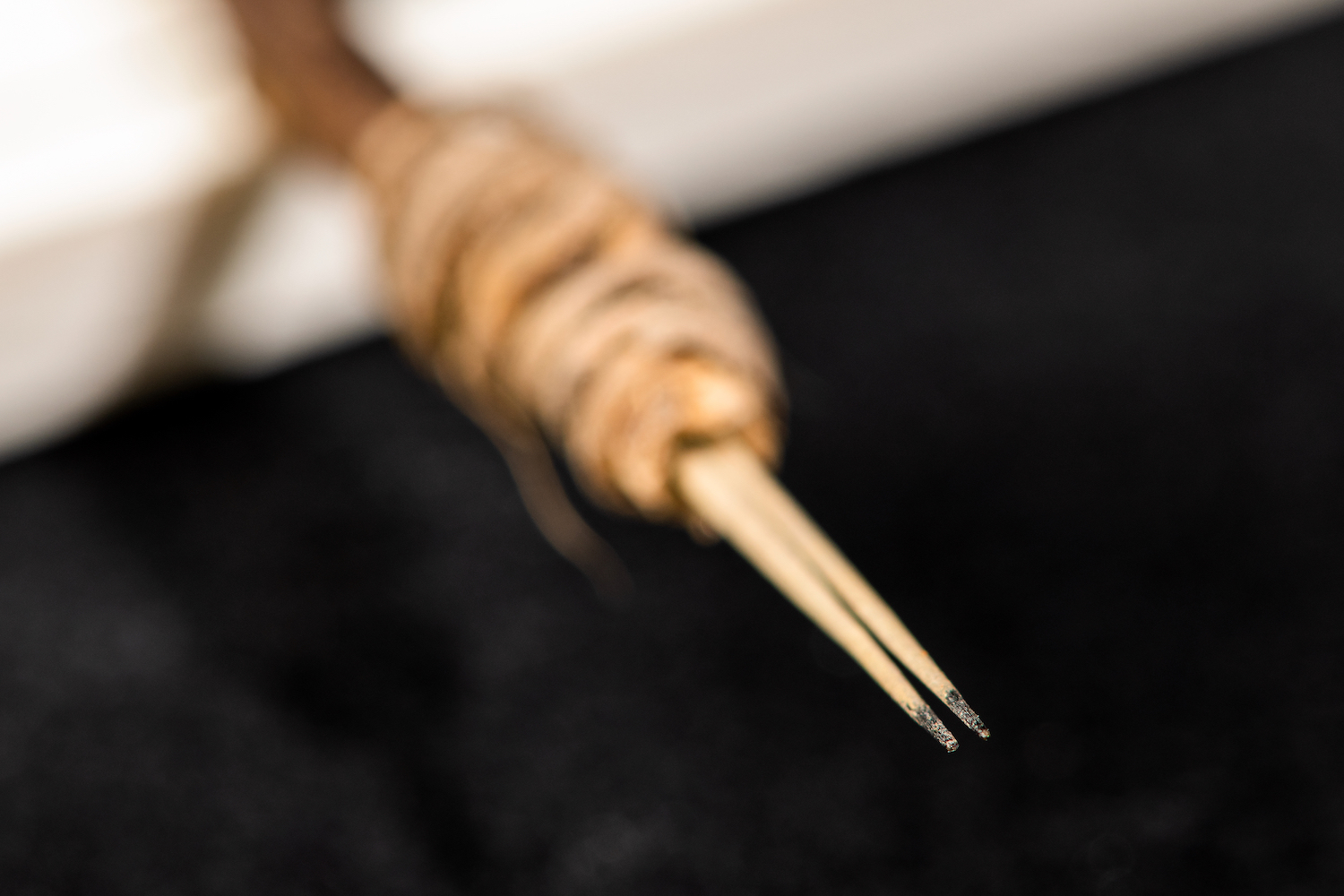Prickly Pear Cactus Needles Are Oldest Tattoo Tool in Western North America

A 2,000-year-old spiky object recently rediscovered in museum storage is the oldest known tattoo-making tool from western North America, a new study finds.
The pen-size tool has two needles made from prickly pear cactus spines, which are tied to a handle of wooden skunkbush sumac (Rhus trilobata) with yucca leaf strips. It was crafted by the ancestral Pueblo people who lived from about 500 B.C. to A.D. 500, during of the Basketmaker II period, in what is now southeastern Utah.
The discovery pushes back evidence of tattooing in western North America by more than 1,000 years, said study lead researcher Andrew Gillreath-Brown, a doctoral student of anthropology at Washington State University, who rediscovered the artifact. [Photos: An Ancient Mummy's Thigh Tattoo]
"Tattooing by prehistoric people in the Southwest is not talked about much because there has not ever been any direct evidence to substantiate it," Gillreath-Brown said in a statement. "This tattoo tool provides us information about past Southwestern culture we did not know before."

Gillreath-Brown happened upon the 3.9-inch-long (9.9 centimeters) tool while taking an inventory of archaeological artifacts that had been in storage for nearly 50 years at Washington State University. The discovery shed lights on Pueblo culture, he said, given that researchers have yet to find any tattoos on the remains of indigenous people who lived in ancient America. Nor are there written records about tattooing from these early cultures, he said.
Instead, researchers have inferred that these cultures had tattoos based on the discovery of other tattoo-making tools. For instance, researchers have found other cactus-spine tattoo tools in what is now Arizona and New Mexico, Gillreath-Brown said. The earliest of these tools dates to between A.D. 1100 and 1280.
The newly identified tool is much older, dating to between A.D 79 to 130, he said.
Sign up for the Live Science daily newsletter now
Get the world’s most fascinating discoveries delivered straight to your inbox.
The tips of the two parallel cactus needles are stained black, he said. "The residue staining from tattoo pigments on the tip was what immediately piqued my interest as being possibly a tattoo tool," Gillreath-Brown said.
To learn more about the tool, Gillreath-Brown analyzed the needles with cutting-edge technology, including a scanning electron microscope. He even did several test tattoos with a replica of the tool on fresh pig skin that was bought at the grocery store.
The results showed that the ink within the needles likely contained carbon, a common element used in body painting and tattooing.
It's possible that tattoos in ancient cultures were used as social markers, Gillreath-Brown and his colleagues wrote in the study. For instance, according to observations from the 1930s on indigenous cultures in the Southwest, the Cahuilla, Kumeyaay, Xalychidom Piipaash and Yavapai give tattoos to women when they hit puberty and enter adulthood, the researchers said. And tattoos are thought to grant the soul of the dead access to the ancestral realm for the Cocopah, Mojave and Xalychidom Piipaash.
In essence, the discovery of the tattoo tool "has a great significance for understanding how people managed relationships and how status may have been marked on people in the past during a time when population densities were increasing in the Southwest," Gillreath-Brown said.
While it's the oldest tattoo tool of western North America, it's hardly the oldest evidence of tattoos in the world. Last year, researchers announced they had found the oldest tattooed woman on record — a 5,000-year-old Egyptian mummy. This woman lived about the same time as Otzi, a famous (and tattooed) mummy found in the Italian Alps and dating back about 5,300 years.
The new study was published online today (Feb. 28) in the Journal of Archaeological Science: Reports.
- 25 Grisly Archaeological Discoveries
- Strange Designs: 5 Weird Ways Tattoos Affect Your Health
- Photos: Pueblo Society Chose Rulers Based on Mother's Line
Originally published on Live Science.

Laura is the archaeology and Life's Little Mysteries editor at Live Science. She also reports on general science, including paleontology. Her work has appeared in The New York Times, Scholastic, Popular Science and Spectrum, a site on autism research. She has won multiple awards from the Society of Professional Journalists and the Washington Newspaper Publishers Association for her reporting at a weekly newspaper near Seattle. Laura holds a bachelor's degree in English literature and psychology from Washington University in St. Louis and a master's degree in science writing from NYU.









